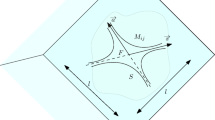Abstract
Alignment of silkworms and fish, observed as seismic anomalous animal behavior (SAAB) prior to the Kobe earthquake, were duplicated in a laboratory by applying a pulsed electric field assuming SAAB as electrophysiological responses to the stimuli of seismic electric signals (SES). The animals became aligned perpendicularly to the field direction since their skeletal muscle had a higher resistivity perpendicular to the field direction than parallel to it. An electromagnetic model of a fault is proposed in which dipolar charges, ±q are generated due to the change of seismic stress, σ(t). From a mathematical model, dq/dt=−α(dσ/dt) − q/ɛρ, where α is the charge generation constant like a piezoelectric coefficient, ɛ, the dielectric constant and ρ, the resistivity of bedrock granite. A fault having a length 2a and a displacement or rock rupture time τ, during which the stress is changed, gives pulsed dipolar charge surface densities, +q(t, x) and −q(t, x+2a), or an apparent electric dipole moment of P(t)=2aQ(t)=2aAq(t)=aM 0[ερ/(τ-ερ)](e-1/τ-e-1/σρ) using the earthquake moment M 0. The fault displacement, D, its initial velocity, D′ and the stress drop, Δσ give τ=D/D′=(Δσ/σ 0)(α/β). The field fintensity, F, and seismic current density at a fault zone, J were calculated as F=q/ɛ and J=F/ρ′ using ρ′ of water as to give J=0.1-1 A/m2 sufficient to cause SAAB experimentally. The near-field ultra low frequency (ULF) waves generated by P(t) give SES reciprocally proportional to the distance R.
Similar content being viewed by others
References
Bastian J, 1994. Electrosensory organs of aquatic animals. Physics Today, 47: 30
Biophysics Institute, Academica Sinica, 1997. Animals Informs Earthquake. Beijing, China. Japanese translation published by Nagasaki Publisher (in Japanese)
Brady B T and Rowell G A, 1986. Laboratory investigation of the electrodynamics of rock fracture. Nature, 321: 488–492
Bushirk R E, Frohlich C and Latha G V, 1981. Unusual animal behaviors before earthquakes: A review of possible sensory mechanisms. Rev Geophys and Space Phys, 19: 247–270
Carlson J M, Langer J S and Shaw B E, 1994. Dynamics of earthquake faults. Rev Mod Phys, 66: 657–670
Derr J S, 1973. Earthquake lights: A review of observation and present theories. Bull Seis Sco Amer, 63: 2 177
Enomoto Y and Hashimoto H, 1990. Emission of charged particles from indentation fracture of rocks. Nature, 346: 641–643
Finkelstein D and Powell J, 1970. Earthquake lighting. Nature, 228: 759–796
Ikeya M, Miki T, Tanaka K, 1982. Dating of a fault with ESR of interfault materials. Science, 215:1392–1393
Ikeya M, 1993. New Applications of Electron Spin Resonance—Dating, Dosimetry and Microscopy —. World Scientific, Singapore, 500
Ikeya M and Takaki S, 1996. Electromagnetic model of a fault for earthquake lightnings (EQLs). Jpn J Appl Phys, 35: L355-L357
Ikeya M, Takaki S and Takashimizu D, 1996a. Electric shocks for seismic animal anomalous behaviors (SAABs). J Phys Sco Japan, 65: 710–712
Ikeya M, Huruta H, Anzai H and Kajiwara N, 1996b. Electric field effects on rats and sparrows for seismic animal anomalies (SAAs). Jpn J Appl Phys, 65: 4587–4594
Ikeya M, 1996. Electromagnetic phenomena and anomalous animal behaviors accompanying earthquakes. Kagaku, 66: 408–418 (in Japanese)
Ikeya M, Takaki S, Matsumoto H, et al., 1997. Pulsed charge model of a fault behavior producing seismic electric signal. J Circuit Systems and Computers, 7(3): 153–164
Kanamoril H and Anderson D, 1975. Theoretical basis of some empirical relations in seismology. Bull Seism Sco Amer, 65: 1073–1095
Kumazawa K, 1961. Disturbances in electromagnetic fied in rocks due to piezoelectric effects in connection with seismic waves. J Sci Nagoya Univ, 9: 54–79
Lockner D A, Johston M J S and Byerlee J D, 1983. A mechanism to explain the generation of earthquake lights. Nature, 302: 28–33
Misakian M A R, Sheppard D, Krause M E, et al., 1993. Biological, physical and electrical parameters for in vitro studies with ELF magnetic and electric fields: A primer. Bioelectromagnetics (Suppl.), 2(1): 1–73
Musuya M, 1995. Jishi Namazu (Earthquake Catfish). Akashi Pubsher (in Japanese)
Rikitake T, 1978. Biosystem behavior as an earthquake precursor. Tectonophysics, 51:1–20
Scholz C H, 1990. The Mechanics of Earthquake and Faulting. Cambridge Press
Terada T, 1931. On luminous phenomena accompanying earthquakes. Bull Earthquake Res Inst Tokyo Univ, 9: 225–255
Tributsch H, 1978. Do aerosol anomalies precede earthquake? Nature, 276: 606–608
Varatos P and Alexopoulos K, 1984. Physical properties of the variations of the electric field of the Earth preceding earthquakes. Tectonophysics, 110: 73–98
Volarovich M P and Sobolev G A, 1965. Use of piezoelectric effects of rocks for subsurface exploration of piezoelectric media. Dokl Akad Nauk SSSR, 162: 11–13
Wadatusmi K, 1995. Statement 1519 of Earthquake Precursor. Tokyo: Tokyo Press, 265pp (in Japanese)
Author information
Authors and Affiliations
About this article
Cite this article
Ikeya, M., Matsumoto, H. & Huang, QH. Alignment silkworms as seismic animal anomalous behavior (SAAB) and electromagnetic model of a fault: a theory and laboratory experiment. Acta Seimol. Sin. 11, 365–374 (1998). https://doi.org/10.1007/s11589-998-0045-3
Received:
Revised:
Accepted:
Issue Date:
DOI: https://doi.org/10.1007/s11589-998-0045-3




